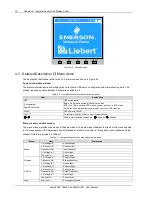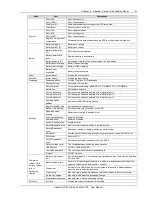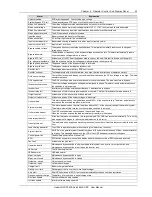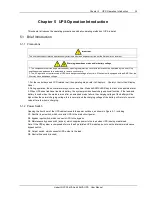
40 Chapter 5 UPS Operation Introduction
Liebert NXC 30kVA And 40kVA UPS User Manual
5.4 Battery Self-test Procedures
The battery self-test includes periodical self-test and manual maintenance self-test. The battery discharge outputs 20%
energy of the total battery energy.
Periodical self-test is to test the battery activity. The periodical self-test is regular, and the self-test period can be
configured via the Emerson setting software. During the periodical self-test, if the battery maintenance requirement is
satisfied, the system will generate audible/visual alarm and corresponding records. The periodical self-test does not
update the battery curve table.
The mode of the manual maintenance self-test is similar to that of the periodical self-test, except for the maintenance
self-test mode is started manually, and this operation is valid only one time, that is the system will not be automatically
start up once you exits. During the maintenance self-test, if the battery maintenance requirement is satisfied, the
system will generate audible/visual alarm and corresponding records. The maintenance self-test does not update the
battery curve table.
Note: The periodical self-test should satisfy the conditions of battery float charge at least 5h, and generator not
connected, while the manual maintenance self-test just satisfies the conditions of battery fully charged.
Achievement
1. Manual maintenance self-test: via the LCD.
2. Periodical self-test: self-test period can be configured via the Emerson setting software. The range of battery
self-test period is 30 days ~ 360 days (default: 60 days).
Self-test startup conditions
1. System load rate is within 20% ~ 100%, stable output.
2. Battery in fully charged state, battery float charge at least 5h, and generator not connected
3. Current system is in float charge state
Self-test exit conditions
1. Confirm that the system is not in self-test state at least 10 seconds, and satisfies the following conditions: in battery
mode or rectifier is closed, and then the system will shift to battery supply state.
2. During the self-test, the system will shift to float charge state if the load fluctuation, UPS module overload or no
battery occurs.
3. During the self-test, if the battery voltage is lower than the calculated pre-alarm voltage, or the battery discharge
exceeds the protection time, then the system will shift to float charge state.
4. The user can manually stop the maintenance test via the LCD.
Note: After the self-test is successful, the system will fully clear the self-test interval counter. If the self-test fails this
time, then exits the system; when self-test conditions are satisfied again, enters self-test once more.
Procedures for manual maintenance self-test
1. Select the Command menu on the LCD screen.
Use the F3 (left) key or F4 (right) key to display the Command menu. Press the F5 (enter) key to confirm it.
2. Select the desired test.
Use the F3 (up) key or F4 (down) key to highlight the desired test item. Press the F5 (enter) key to confirm it.
After the prompt, use the F3 (up) and F4 (right) keys to input the password, and then press the F5 (enter) key to
confirm it.
3. Wait until the battery test completes.
After the test, the system will automatically update the battery data which used to calculate the backup time (displayed
upon mains failure), and battery actual capacity (battery capacity percentage when compared to a new battery,
displayed in inverter mode).
4. Stop the battery test.
If required, the test may be stopped before completion by selecting Stop testing on the Command menu.
Refer to
Chapter 4 Operator Control And Display Panel
for more information.
Summary of Contents for NXC 30kVA
Page 2: ......
















































